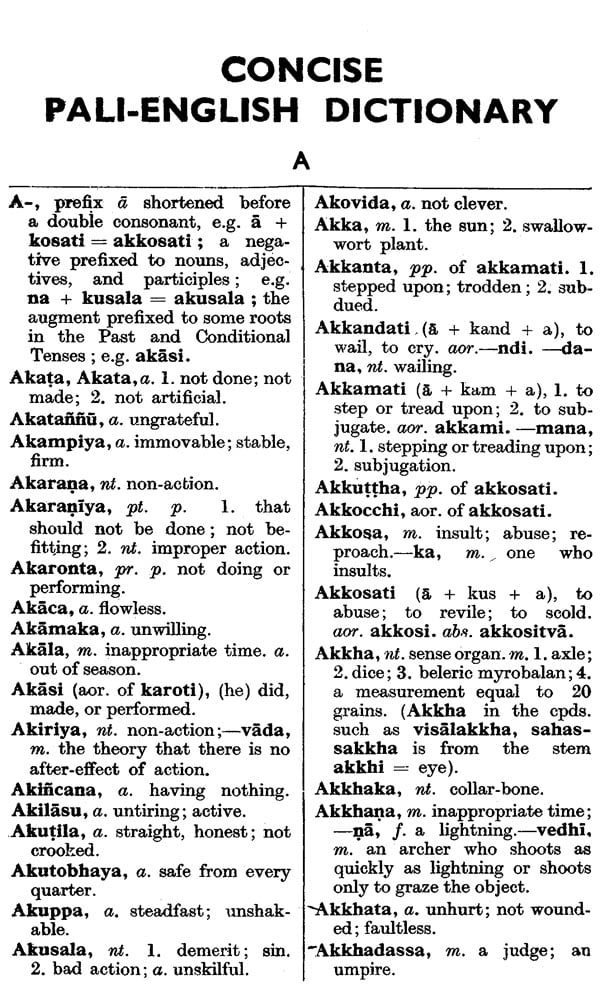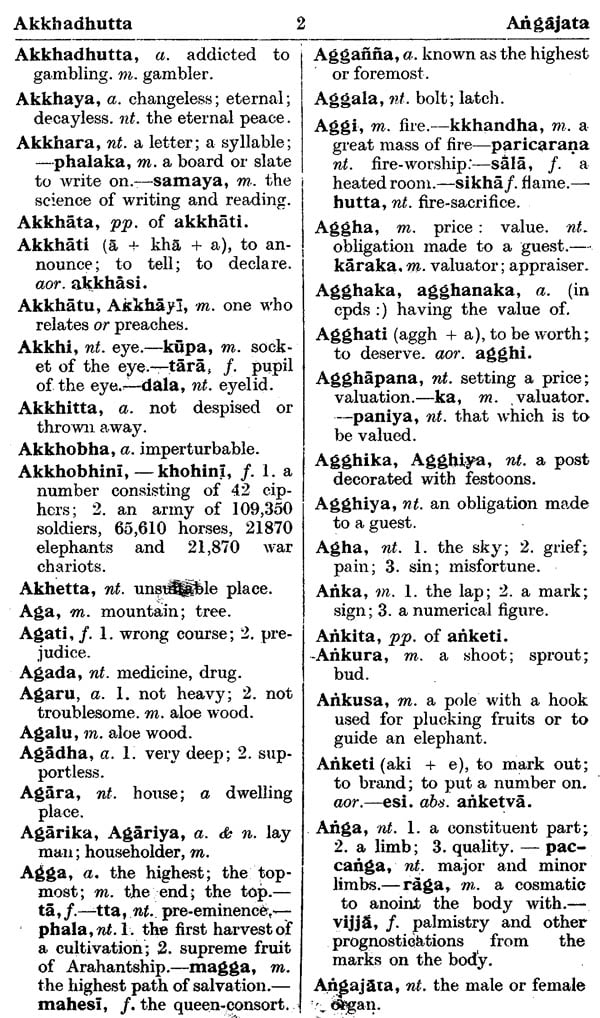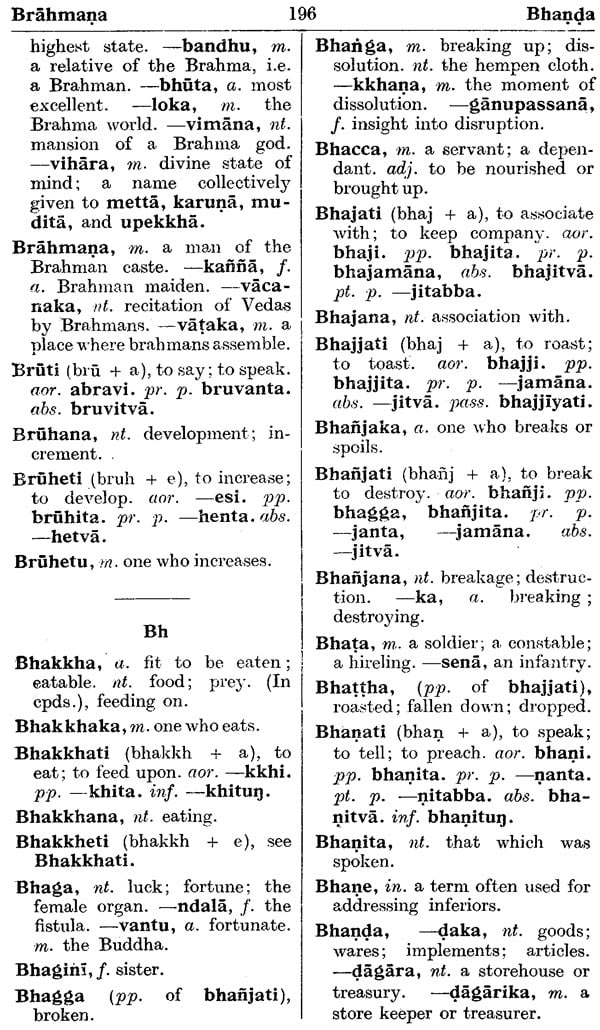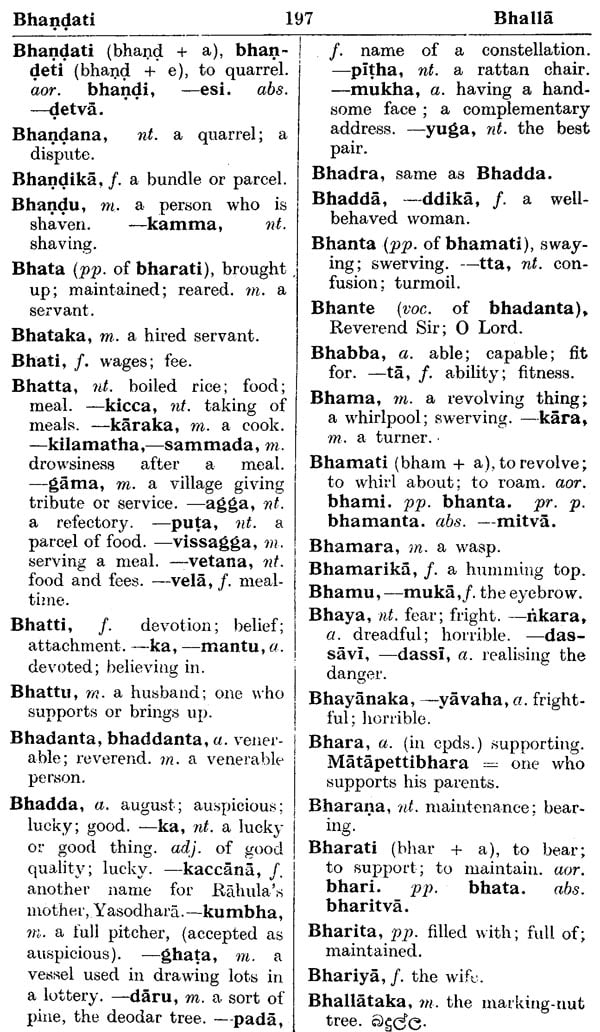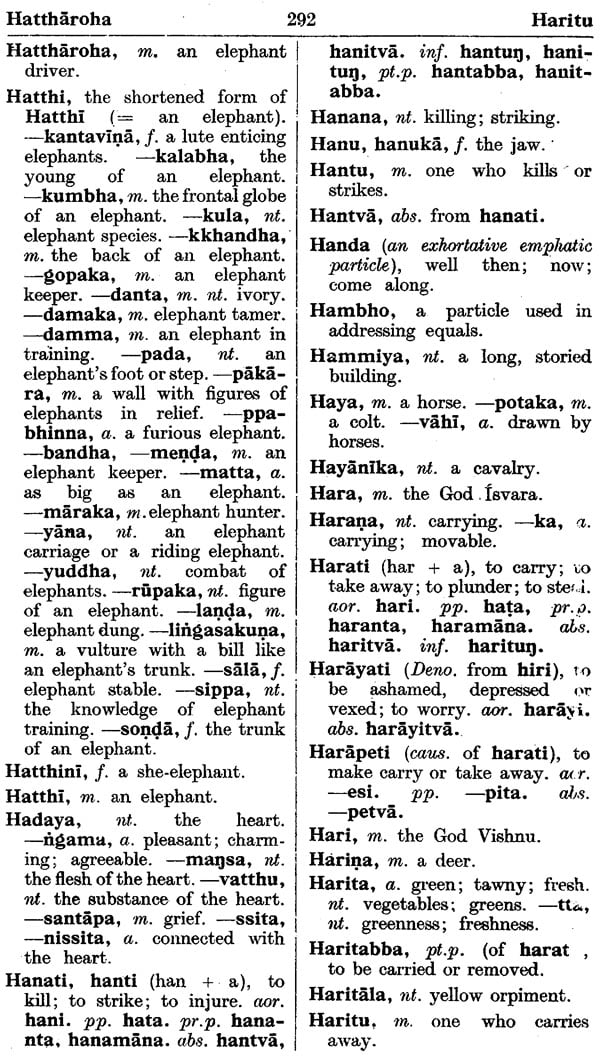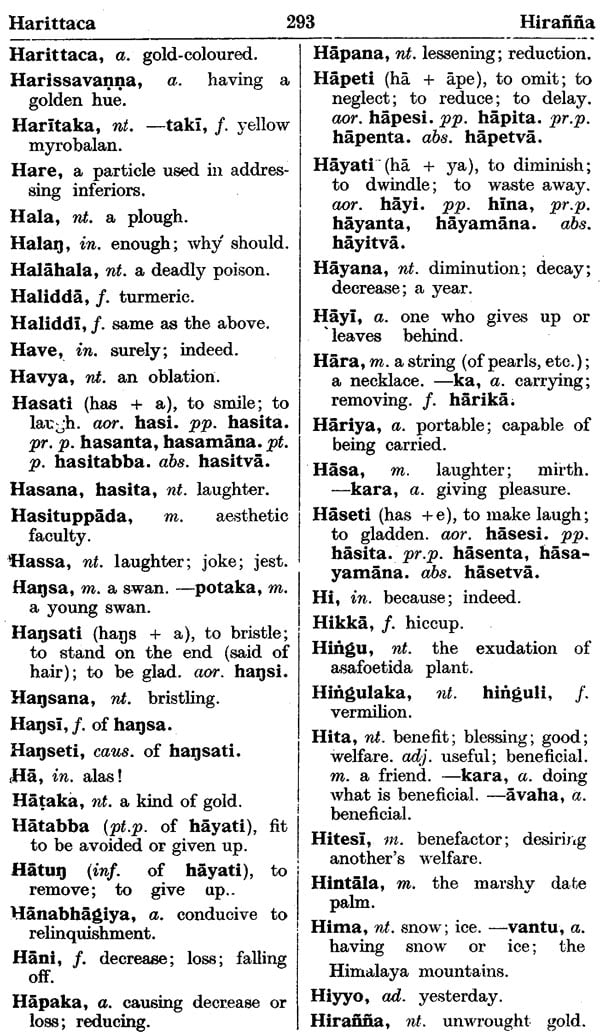
Concise Pali-English Dictionary
Book Specification
| Item Code: | IDD449 |
| Author: | A.P. Buddhadatta Mahathera |
| Publisher: | MOTILAL BANARSIDASS PUBLISHERS PVT. LTD. |
| Language: | English |
| Edition: | 2014 |
| ISBN: | 9788120806054 |
| Pages: | 302 |
| Cover: | Paperback |
| Other Details | 8.5" X 5.5" |
| Weight | 340 gm |
Book Description
This Concise Pali -English Dictionary has been prepared mainly for use by students in schools and colleges. The author is not only an eminent Elder of the Buddhist Order but one of the leading Pali scholars recognized both in the East and the West as an authority on the subject.
It is to be observed that the author has kept more or less to the traditional sense of words while not altogether ignoring the meaning given by Western scholars in their translations and lexicons. Many errors in the latter sources have also been rectified. But the basic sense adopted is in nearly every instance the traditionally accepted meaning in accord with the commentaries and the glossaries. This perhaps is of special value to beginners as thereby they get introduced to the indigenous tradition, thus providing a useful basis on which to build up a more scientific knowledge as the study advances.
A concise Pali-English Dictionary for use by students in schools and colleges has been a long-felt need. The only available Pali- English lexicon—the work of Childers being long out of print— is the famous publication of the Pali Text Society, but this too is fast becoming rare and difficult to procure. In any case the cost is too heavy for the average student. Hence it is gratifying to note that at long last a reputed scholar has come forward to satisfy this need and after several years of hard work has compiled what may prove to be the standard practical dictionary of the Pali language.
The author is not only an eminent Elder of the Buddhist Order but one of the leading Pali scholars recognized both in the East and in the West as an authority on the subject. His experience as a teacher at Ananda College, Colombo, and the considerable experience he has gained as a writer of text-books for school use, such as the now famous New Pali Course, make him admirably suited for the undertaking. There are but a few Buddhist Elders in direct contact with western scholarship through the English medium and the Rev. Buddhadatta is the most senior among that class of monks.
It is to be observed that the author has kept more or less to the traditional sense of words while not altogether ignoring the meanings given by western scholars in their translations and lexicons. Many errors in the latter sources have also been rectified. But the basic sense adopted is in nearly every instance the traditionally accepted meaning in accord with the commentaries and the glossaries. This, perhaps, is of special value to beginners as thereby they get introduced to the indigenous tradition, thus providing a useful basis on which to build up a more scientific knowledge as the study advances.
I am certain that this dictionary will be found indispensable by all students of the Pali language in acquiring a practical and working knowledge of the subject even at the University level, and also serve as a reliable guide to the more abstruse language of the Tipitaka.
Some twenty-five years ago when the teaching, of Pali was commenced at- Ananda College, the text-books used by Buddhist monks, which were centuries old, were found unsuitable for use by its pupils. Mr. P. de S. Kularatna, then Principal of Ananda •College, who appointed me as tutor in Pali, urged me to produce some suitable text-books, and I wrote in three parts the Palibhashavatarana in Sinhalese and compiled a Pali Reader named Palipathavali.
Later I wrote the New Pali Course in two parts for the benefit of those who wished to learn Pali through the medium of English. This book is used even in some foreign countries, and is now in its third edition. A Higher Pali Course too is now ready for the press.
There yet lacked for the study of Pali a concise Pali-English Dictionary and an English-Pali Dictionary. The Pali•English Dictionary of the Pali Text Society is too large and too expensive for those studying in schools and colleges. Therefore I prepared two such works during the war, but owing to paper control, which was lifted only recently, the Pali-English Dictionary- alone is now appearing in print. The English-Pali Dictionary will be printed as early as possible.
In compiling this work I have constantly referred to the Pali- English Dictionary, published by the Pali Text Society (of England). but I have not followed its method. In some places I have not accepted the meanings and constructions it has given; for instance, the construction of anubhuva is given by me as anu + abhava, in agreement with the commentaries, while the P. T. S. Dictionary gives it as (ana + abhava. There is no prefix ana in Pali, and na before a vowel is changed to cm and not to ana. Moreover na + abhava would mean "non-cessation ", and not “utter cessation “as the P. T. S. Dictionary gives it. Similar is the construction given there for anugghateti as an + ugghateti. The meaning given there for terovassika is “lasting over or beyond a year (or season) "; here to stands, according to the commentary: for three, and ro represents “four "; then terovassika means 1 " three or four years old ".
I have included some important words missing in that dictionary although my work is of smaller compass. In giving the roots of verbs I have preserved their traditional Pali forms as far as possible though the P.T.S. Dictionary has always followed the Sanskrit Dictionaries.
My thanks are due to Prof. O.H. de A. Wijesekara. M,A., Ph. D., and Dr. G.C. Mendis, B.A., Ph.D., both of the University of Ceylon, who encouraged me to begin this work. Prof. Wijesekara has always readily helped me whenever I met with any difficulty. He has now kindly consented to revise my English – Pali Dictionary.
Pali verbs are given here in the third person singular of the present tense. As there are different ways of forming the aorist and past participle I have given both these forms too under each verb. The P.P is sometimes separately given when it has some meaning not expressed by the verb or when it is difficult to understand from which verb it is derived. Ordinary absolutives ending in tva and tvana are not generally given after the verbs but the peculiar forms such as nikkamma pahaya, ucchijja are given. It is not to be understood however that these stems do not have their general forms ending in tva or tvana.
The Pali English dictionary of the Pali Text society has given stem of some Pali nouns with consonantal endings viz sathar pilar Brahman but I have not followed this method as none of the Pali Grammarians have adopted it. They have always given these stems with vowel endings.
The secondary derivatives ending in ta are included in the feminine they have their neuter forms ending in tta and ttava but for the sake of brevity only one form either ending in ta or tta is given one place.
Of Related Interest :
TOPICS IN PALI HISTORICAL PHONOLOGY
Click Here For More Books on the Pali Language
